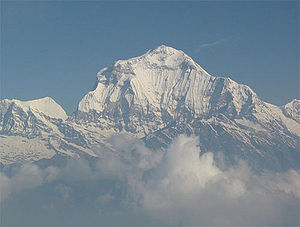Dhaulagiri
| Dhaulagiri | ||
|---|---|---|
|
The south face of Dhaulagiri |
||
| height | 8167 m | |
| location | Myagdi District ( Nepal ) | |
| Mountains | Dhaulagiri Himal ( Himalaya ) | |
| Dominance | 317.47 km → Cho Oyu | |
| Notch height | 3357 m | |
| Coordinates | 28 ° 41 '46 " N , 83 ° 29' 43" E | |
|
|
||
| First ascent | May 13, 1960 Kurt Diemberger , Peter Diener , Ernst Forrer, Albin Schelbert, Nawang Dorje and Nyima Dorje | |
| Normal way | Northeast ridge | |
|
The Dhaulagiri from the northeast with east face, northeast ridge and north face |
||
Dhaulagiri ("White Mountain", nepali : धौलागिरी Dhaulāgirī ) is the highest peak of the Dhaulagiri Himal in the Himalayas . At 8,167 m, it is the seventh highest mountain in the world within all 14 eight-thousanders . Separated by the Kali Gandaki valley, the Annapurna rises - about 35 km east of Dhaulagiri .
During a survey in 1809 by Lieutenant William Spencer Webb and Captain John Hodgson, the height of Dhaulagiri was determined to be 8190 m . It was the first eight-thousander to be discovered and from then until the Kangchenjunga was measured in 1838, it was considered the highest mountain on earth (→ Chronicle of the highest mountains on earth ).
Ascent history
The Dhaulagiri was climbed as the penultimate eight-thousander. Only members of the eighth expedition, an international expedition led by the Swiss Max Eiselin , managed to reach the summit in May 1960. For the first time and so far unique in the history of mountaineering , it used a small aircraft to transport the equipment and the expedition members to base camp 2 at an altitude of 5700 m . The small aircraft named Yeti , a Pilatus Porter PC-6 , crashed in one of the difficult take-off maneuvers at this altitude on May 5, 1960 without anyone being injured. Building on the experience and safety ropes of the seventh failed expedition - in 1959, under the direction of Fritz Moravec - the north-east ridge was chosen as the ascent route. On May 13, 1960, a team of six from among the expedition participants - Kurt Diemberger , Peter Diener , Ernst Forrer , Albin Schelbert and the two Sherpas Nawang Dorje and Nyima Dorje - managed to climb to the summit. On May 23, 1960, two other expedition participants, Michel Vaucher and Hugo Weber, succeeded.
On May 6, 1982, the Belgian Lut Vivijs became the first woman to climb Dhaulagiri. She was a participant in the Belgian Dhaulagiri-I expedition. From this expedition a total of five climbers and two Sherpas reached the summit, including Jan Vanhees, Lut Vivijs' husband. They rose over the northwest ridge.
The Dhaulagiri south face was conquered on November 2, 1999 for the first time by the Slovenian Tomaž Humar single-handedly . However, Humar did not reach the summit, but only an altitude of about 8000 m.
literature
- Max Eiselin: Success on Dhaulagiri . Orell Füssli Verlag, Zurich, 1960. (Report of the first climbers)
Web links
- Dhaulagiri on Peakbagger.com (English)
- Dhaulagiri at Peakware (English)
- Ascension story at himalaya-info.org (private website)
Individual evidence
- ↑ Norman G. Dyhrenfurth: The Mountain of Storms - Dhaulagiri 1960. In: American Alpine Journal 1961, pp. 231-248 (AAJO) (PDF; 4.3 MB), accessed on August 24, 2011.
- ↑ Peter Grypendonck: In the shadow of Everest, Eupen 1990, Grenzecho-Verlag, ISBN 3-923099-73-8
- ↑ Fatal solo tour: Slovenian extreme mountaineer crashed in the Himalayas. In: Spiegel Online . November 14, 2009, accessed January 6, 2017 .


